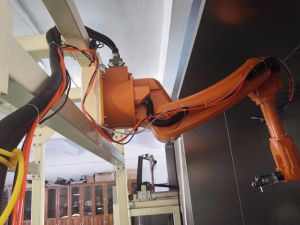Washing machine mask spraying
Spraying robot, also known as spray painting robot, is an industrial robot that can automatically spray paint or spray other paints. The paint spraying robot is mainly composed of a robot body, a computer and a corresponding control system. The joint structure is usually 5 or 6 degrees of freedom. The arm has a large movement space and can perform complex trajectory movements. The wrist generally has 2 to 3 One degree of freedom, flexible movement. The more advanced spraying robot wrist adopts a flexible wrist, which can be bent in all directions and can be rotated. Its action is similar to that of a human wrist, and it can easily extend into the workpiece through a smaller hole and spray its inner surface. Paint spraying robots are generally hydraulically driven, which has the characteristics of fast movement speed and good explosion-proof performance, and can be taught by hand-to-hand teaching or point-by-point teaching. Paint spraying robots are widely used in process production departments such as automobiles, meters, electrical appliances, and enamel.
The main advantages of spraying robot (1) great flexibility. The scope of work is large. (2) Improve spraying quality and material usage. (3) Easy to operate and maintain. Can be programmed offline, greatly reducing on-site debugging time. (4) High equipment utilization. The utilization rate of spraying robot can reach 90%-95%.
Features: 1. Flexible.
(1) The scope of work is large, and the possibility of audit is large.
(2) The inner surface and outer surface can be sprayed.
(3) A variety of shapes can be painted on the surface, such as cars, motorcycles, washing machines, refrigerators, etc.
2. Improve spraying quality and material usage.
(1) Accurate profile spraying trajectory, improve the uniformity of the coating film and other appearance spraying quality.
(2) Reduce the amount of over-spraying and cleaning solvent, and improve the material utilization rate.
3. Easy to operate and maintain.
(1) Offline programming can greatly shorten the on-site debugging time.
(2) Plug-in structure and modular design can realize rapid installation and replacement of components, greatly reducing maintenance time.
(3) All components have good accessibility for maintenance.
4. High equipment utilization.
Introduction of welding robot: Welding robot is an industrial robot engaged in welding (including cutting and spraying). According to the definition of the International Standardization Organization (ISO) Industrial Robot Terminology Standard Welding Robot, an industrial robot is a multi-purpose, reprogrammable automatic control manipulator (Manipulator) with three or more programmable axes for Industrial automation. In order to adapt to different uses, the mechanical interface of the last axis of the robot is usually a connecting flange, which can be connected with different tools or end effectors. Welding robots are equipped with welding tongs or welding (cutting) guns on the final shaft flange of industrial robots to enable welding, cutting or thermal spraying.



